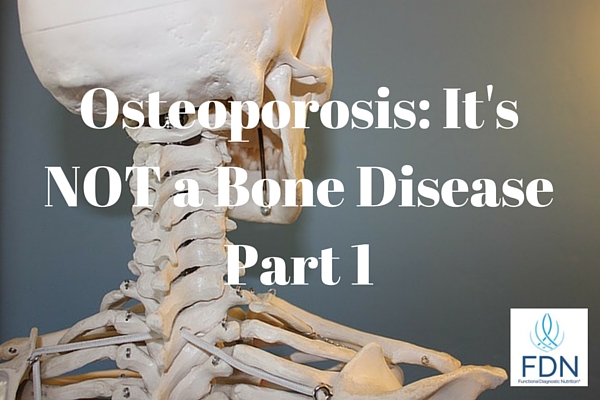Bone is one of the strongest materials found in nature. Ounce for ounce, bone is stronger than steel, since a bar of steel of comparable size would weigh four or five times as much. One cubic inch of bone can in principle bear a load of 19,000 lbs. or more — roughly the weight of five standard pickup trucks — making it about four times as strong as concrete.
With a substance so strong making up our skeleton, one would think that we would be unbreakable. Well, we used to be pretty close. Or at least a lot less fragile. Modern humans have a relatively lightly built skeleton compared with those of chimpanzees (the closest living relatives to humans) as well with those of extinct human lineages. It appears that our skeleton is only half as dense as those of our early ancestors.
So what happened? How did our bones become weak? We’ll discuss this and more in Part 1 of our two part series on Osteoporosis.
Research has found that bone density remained relatively constant over the course of human evolution, but sharply declined in the modern era. The drop in bone density correlates with shift from hunting and foraging to agriculture and industrialization.
It would appear that our modern lifestyles, food, and environment has taken a toll on our bones. Osteoporosis is a serious concern for our aging population. The National Osteoporosis Foundation estimates significant bone loss is a public health threat for 55 percent of people 50 years old and up in the United States.
The good news is that problems with bone health can be prevented and even reversed through simple tools at your fingertips. No need to travel back in time to the Paleolithic era, or leave your modern lifestyle to become a hunter-gatherer.
In this week’s article we will pull the skeleton out of the closet and take a good hard look at it. Learn all about your bones – their function in the body, what causes conditions like Osteoporosis, why traditional treatments fail, and how to keep your frame strong for many years to come.
Bone Health
If you are like most adults, you probably don’t think too much about it. Aside from marking how many inches your kids have grown on the wall, people tend to forget about bone health until they are faced with a break, fracture, or other damage to the skeletal system. Most of us think of bones as relatively static and unchanging structures. With closer examination, you will find bones are dynamic, regenerative organs with their own metabolic processes critical to overall health.
Bones perform four vital roles, three of which, structural support, organ protection, and red blood cell production, are commonly acknowledged. The fourth, equally important but lesser known function, is the storage of minerals for use by other parts of the body. This storage function of the bones is kind of like a mineral “bank” for your body from which your tissues can borrow. The most plentiful of these stored minerals is calcium; however, other minerals include magnesium and phosphorus.
Deposits and Withdrawals
Blood levels of calcium are tightly regulated, and kept within a very narrow range. This is one of the most strictly controlled processes in the body. When calcium blood levels start to fall below this range, stored calcium can be “withdrawn” from the bones in a process called resorption. On the other hand, as calcium blood concentrations start to approach the upper limit, calcium is often “deposited” back into the bones matrix in a process called absorption. These two processes, resorption and absorption are constantly “remodeling” or changing the shape and structure of the bone.
Why is the regulation of blood calcium so important? Proper serum calcium levels are necessary for generation of muscle contractions and nerve impulses, which are electrically stimulated. If calcium levels get too high, membranes become less responsive and can result in muscle weakness, brain fog, and other complications. Conversely, if calcium levels get too low, membrane permeability to sodium increases, and convulsions or muscle spasms may result. Luckily, our bodies have some very intuitive homeostatic control mechanisms in place to help keep serum calcium in balance.
Hormonal Control of Blood Calcium Levels
Blood calcium levels are regulated by parathyroid hormone (PTH), which is produced by the parathyroid glands. These small glands are located in the neck and sit behind the thyroid gland. PTH is released in response to low blood calcium and delivers messages to the skeleton, the kidneys, and the intestine. In the skeleton, PTH stimulates osteoclasts, which are cells that cause bone to release calcium into the blood. PTH also inhibits osteoblasts, cells which deposit bone, reducing the amount of calcium absorption in bone. In the intestines, PTH plays a role to increase the absorption of dietary calcium. In the kidneys, PTH stimulates reabsorption of the calcium. Just as the release of PTH is stimulated by low blood calcium, it is inhibited by rising blood calcium levels.
In addition to maintaining mineral blood levels (homeostasis), bone may remodel for other reasons. As children grow into adulthood, some bones, like those in the skull, will fuse together, while growing in length and girth. During pregnancy, the additional load calls on the bones to meet the new demands. Exercise forces bone remodeling as muscles grow and require more skeletal support. And, the normal stresses of life cause micro- and mini-fractures in bone tissues that normally go unnoticed but ultimately weaken structural strength. Bone remodeling is the process the body uses to shape and heal these fractures.
In some people, withdrawal of calcium from the bones can be abnormally high and deposition of calcium in the bones abnormally low. When calcium withdrawals in the bone continually exceed deposits, it leads to a deficit. Similar to your bank account, this deficit isn’t good news. A calcium deficit results in osteoporosis.
Osteoporosis – Not A Bone Disease
Breaking News! (Please excuse the pun.) Osteoporosis is NOT a bone disease.
With that said, osteoporosis IS a serious topic. The condition is epidemic in our country; over 45 million Americans have been diagnosed with it. In addition, while this used to be mostly a female concern, we are seeing more and more men diagnosed in recent years. The popular (although misleading) theories regarding prevention and treatment for osteoporosis focus on “getting plenty of calcium” to curtail the potentially debilitating effects of bone loss. This is a massive oversimplification and an extremely narrow view of the very broad topic of bone health.
Generally speaking, the allopathic medicine approach to treating osteoporosis includes increasing some combination of calcium intake, medications, vitamin D supplementation, and sometimes exercise. The problem is, after a year or two of treatment, bone mineral density often shows minimal improvement, if any, and in some cases, gets worse. This type of approach to the bone-mineral density issue is akin to putting out a forest fire with an eyedropper. It just isn’t enough. In Part 2, we’ll look at the underlying causes of osteoporosis.







